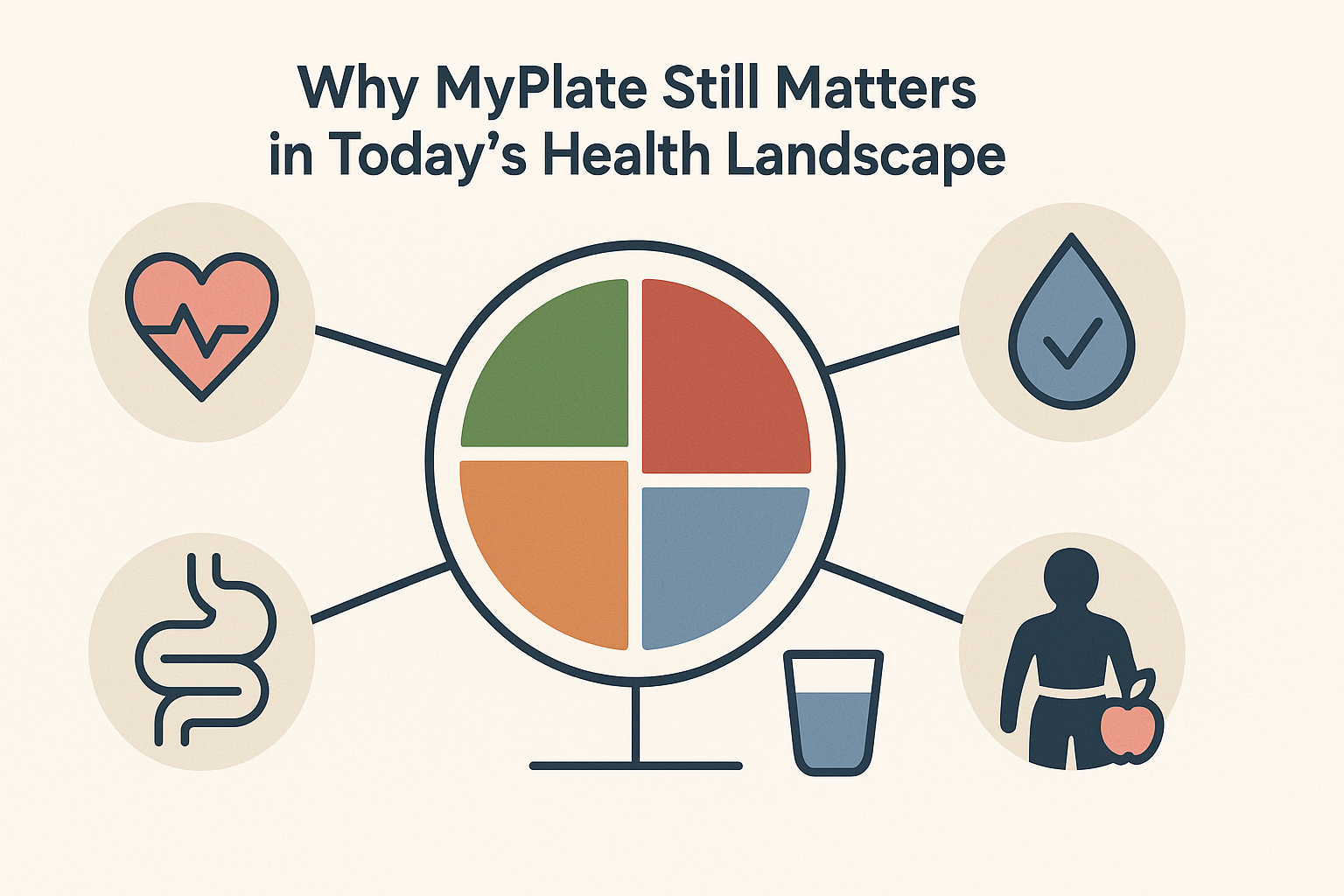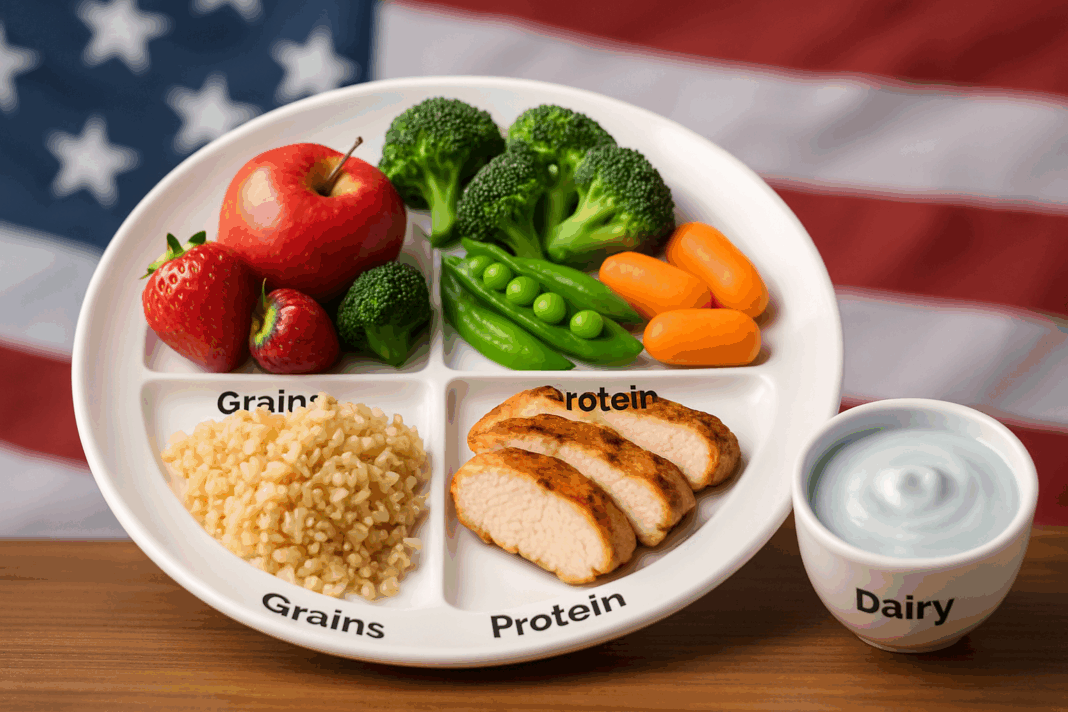In the complex and evolving world of nutrition science, few public health tools have had as significant and enduring an impact on dietary education as the MyPlate graphic. As a successor to the long-standing food pyramid, MyPlate presents a simplified, visually intuitive guide to healthy eating. Its creation was not a spontaneous event but a calculated move by a specific government institution to address escalating nutrition-related health issues in the United States. Understanding what agency created MyPlate is not just a matter of bureaucratic trivia—it holds deeper implications for public trust, policy, and long-term health outcomes. This article explores the origins of MyPlate, the role of the government agency that created it, and why this effort continues to shape how Americans think about nutrition, particularly through tools such as the MyPlate food groups, educational outreach like the MyPlate Champion slogan, and integration with national dietary guidelines.
You may also like: 4 Ways to Have a Healthy Diet: Expert Tips Backed by Science for Better Nutrition and Long-Term Wellness
The Birth of MyPlate: Replacing the Food Pyramid
Before MyPlate came into existence, the United States relied on the Food Pyramid as its primary dietary guidance graphic. Introduced in 1992 by the U.S. Department of Agriculture (USDA), the Food Pyramid aimed to represent recommended proportions of different food groups visually. However, as nutritional science evolved and criticism of the pyramid’s simplicity and lack of clarity grew, it became increasingly clear that a new model was needed. Enter MyPlate, launched in 2011 by the USDA—a direct answer to these concerns. This makes the USDA the definitive answer to the question of what government agency created MyPlate. In creating MyPlate and dietary guidelines for modern use, the USDA leveraged decades of research to build a model that was not only educational but also actionable.
The new graphic was designed to be easy to understand at a glance, featuring a plate divided into four main sections—fruits, vegetables, grains, and protein—with a side of dairy. This shift marked a fundamental change in how dietary recommendations were communicated. While the Food Pyramid presented an abstract hierarchy of food groups, MyPlate mimicked the literal layout of a meal, helping users visualize proper proportions more intuitively. The change also allowed the USDA to expand its role in disseminating dietary information to the public in a way that was visually modern and aligned with contemporary eating habits.
USDA: The Government Agency Behind MyPlate
When examining what government agency created MyPlate, the U.S. Department of Agriculture stands central. The USDA has long held responsibility for generating federal dietary guidance. Through its Center for Nutrition Policy and Promotion (CNPP), the agency provides science-based dietary advice to promote health and reduce the risk of chronic diseases. In launching MyPlate, the USDA was not only updating its visual guidance but also reinforcing its authority as the primary entity responsible for national nutrition education.
This affiliation matters because it imbues the MyPlate initiative with credibility and public trust. As an agency with deep roots in agricultural policy, food safety, and nutrition science, the USDA’s oversight ensures that MyPlate is grounded in evidence-based research and reviewed regularly to incorporate new scientific findings. The USDA’s involvement also ties MyPlate directly to the Dietary Guidelines for Americans, which the agency co-develops with the Department of Health and Human Services every five years. This synergy between government bodies strengthens the educational message of MyPlate and enhances its alignment with evolving scientific consensus.
In the context of what government created MyPlate and dietary information at large, it’s also important to note the USDA’s unique position. Unlike private or commercial health tools that may have conflicting interests, the USDA operates with a public health mandate. This allows for greater transparency in its recommendations and supports initiatives like the MyPlate Champion slogan, which encourages community-level advocacy and personal accountability for healthy eating.

How MyPlate Simplifies Nutrition Education
One of MyPlate’s greatest strengths lies in its simplicity. Unlike more abstract models, it delivers a clear and direct message: balance your plate. Each segment of the plate represents a core food group, and together they illustrate how a typical meal should be structured. In doing so, MyPlate has succeeded in demystifying complex nutritional advice for the average American. The MyPlate food groups—fruits, vegetables, grains, protein, and dairy—serve as easy reference points that help people assess and improve their daily meals.
This clarity has real-world implications. Research has shown that visual tools can significantly improve dietary choices, especially among children, adolescents, and individuals with limited health literacy. MyPlate allows families, educators, and healthcare providers to communicate nutritional goals effectively and consistently. It also facilitates school-based programs and workplace wellness initiatives that promote healthy eating habits in a structured manner.
Moreover, the USDA designed MyPlate with adaptability in mind. It can be customized to suit various dietary needs, including vegetarian, vegan, gluten-free, and culturally specific diets. This flexibility ensures that the tool remains inclusive while still emphasizing the foundational principles of balanced nutrition. In this way, the initiative created MyPlate and dietary guidelines that are both scientifically robust and widely accessible.

The Role of Vegetables in the MyPlate Framework
Vegetables occupy a prominent space in the MyPlate design for a good reason. Among the five MyPlate food groups, vegetables are perhaps the most diverse in terms of nutrient density and health benefits. They are rich in essential vitamins, minerals, fiber, and antioxidants—components that play critical roles in disease prevention and health maintenance. When people wonder what nutrient comes from vegetables, the answer is multifaceted: vegetables provide vitamins A, C, K, and many B-complex vitamins, along with potassium, magnesium, and a host of phytonutrients.
Understanding what are 3 health fact for vegetables further underscores their value. First, vegetables support immune function due to their high vitamin C content. Second, they promote digestive health thanks to dietary fiber, which enhances gut motility and supports beneficial gut bacteria. Third, vegetables help regulate blood pressure and cardiovascular health through their potassium content and low sodium levels. These insights help explain why including vegetables in your diet is a foundational recommendation across all major dietary guidelines.
Different veggies offer distinct health advantages. Leafy greens like spinach and kale are excellent sources of iron and folate. Cruciferous vegetables such as broccoli and Brussels sprouts are known for their cancer-fighting compounds. Root vegetables like carrots and beets provide unique antioxidants and fiber. When discussing examples of vegetables, it’s crucial to highlight this diversity not just in flavor but in nutritional profile. The USDA’s guidance created MyPlate and dietary information to reflect these nuances, helping Americans make informed choices about which vegetables are best for them.

Fruits and the Body: More Than Just Sweet Treats
Fruits are often celebrated for their taste, but their nutritional contributions are equally noteworthy. Within the MyPlate structure, fruits occupy a quadrant that reminds individuals to make them a staple part of daily meals. But what does fruit provide for the body? Primarily, fruits deliver a wealth of vitamins like C and A, dietary fiber, and natural sugars that offer quick energy without the crash associated with refined carbohydrates. They also contain unique compounds such as flavonoids and polyphenols that contribute to long-term health benefits.
A diet rich in fruits can lower the risk of many chronic diseases, including heart disease, type 2 diabetes, and certain cancers. The antioxidants found in fruits help neutralize free radicals, reducing inflammation and cellular damage over time. This makes a fruit and veggie diet a powerful tool for disease prevention and health optimization. As more Americans adopt this dietary pattern, the importance of government-led initiatives like MyPlate becomes even clearer. By positioning fruits prominently on the plate, the USDA reinforces their value and encourages consistent consumption.
When exploring examples of veggies and fruits together, it becomes evident that both offer synergistic benefits. Combining leafy greens with citrus fruits, for instance, enhances iron absorption due to the vitamin C content. This is just one practical example of how MyPlate isn’t just about visual simplicity but also about fostering nutrient-rich combinations that optimize health outcomes.

The MyPlate Champion Slogan and Public Engagement
In promoting dietary awareness, visual tools alone are not sufficient. Messaging campaigns play a crucial role in motivating behavior change. One such initiative is the MyPlate Champion slogan, which encourages individuals and communities to take active roles in promoting healthy eating. The slogan—”Start Simple with MyPlate”—is designed to make dietary change feel attainable and non-intimidating. It reflects the USDA’s understanding that lifestyle change is a process, not an overnight transformation.
This public engagement effort has yielded impressive results. Schools have adopted the slogan into their lunchroom education programs. Healthcare providers use it in patient counseling, and nonprofit organizations have integrated it into community outreach. These efforts collectively reinforce the value of MyPlate as more than a static guide—it becomes a living, evolving framework for action.
Being a MyPlate Champion also allows individuals to personalize their health journey. By adopting the slogan, people commit to small, sustainable changes—such as adding one more vegetable to their meals each day or replacing sugary drinks with water. These micro-adjustments, when repeated over time, align with the principles that created MyPlate and dietary guidelines focused on incremental improvement and long-term health.
Why MyPlate Still Matters in Today’s Health Landscape
In an age saturated with diet trends, influencer opinions, and conflicting nutritional advice, the enduring relevance of MyPlate cannot be overstated. What government agency created MyPlate matters because it speaks to the authority, consistency, and scientific foundation behind the guidance. The USDA’s continued stewardship ensures that the platform evolves with emerging research while remaining grounded in public health priorities.
At a time when obesity, diabetes, and cardiovascular disease continue to pose significant challenges, having a reliable, easy-to-understand tool is more important than ever. MyPlate provides that anchor. It doesn’t chase fads or cater to sensationalism. Instead, it offers a framework rooted in evidence and designed for practical use across a wide range of demographics. This makes MyPlate not just a visual tool but a symbol of the government’s ongoing commitment to public nutrition.
The platform’s continued focus on promoting the five food groups—including vegetables and fruits—reinforces messages that are universally applicable. Whether someone is trying to manage weight, improve heart health, or simply eat more mindfully, the MyPlate model offers a trustworthy starting point. Understanding what agency created MyPlate and why is crucial for appreciating the integrity behind the message and trusting its recommendations.

Frequently Asked Questions: Understanding MyPlate and Its National Impact
1. How did the USDA’s long-term research efforts contribute to the development of MyPlate?
The process that created MyPlate and dietary guidelines was the result of years of interdisciplinary collaboration, data analysis, and public health research spearheaded by the USDA. Rather than designing a nutrition guide overnight, the USDA analyzed epidemiological trends and clinical outcomes over decades to understand how Americans actually eat. What agency created MyPlate is important because it reflects this commitment to data-driven decisions, ensuring that the recommendations are rooted in scientific rigor. Their findings showed that the food pyramid was misinterpreted by the public and led to unintended dietary imbalances. The creation of MyPlate was, therefore, a recalibration—emphasizing balance, portion control, and a visually intuitive format to reshape national eating habits.
2. What are some ways the MyPlate Champion slogan has influenced school health programs?
The MyPlate Champion slogan has been widely adopted in school systems to foster early nutrition literacy. With colorful displays, interactive lessons, and cafeteria signage, children learn the value of balanced meals from a young age. Schools have used the slogan to promote healthy competition and reward students who consistently follow dietary guidelines. Because what government agency created MyPlate also developed these school-oriented resources, there’s a high level of consistency between classroom teachings and national policy. This alignment helps embed long-term habits, turning MyPlate into a foundational tool for the next generation.
3. How does MyPlate accommodate cultural dietary practices while still following federal guidelines?
One of MyPlate’s strengths lies in its flexibility. While it maintains core principles laid out by the government agency that created MyPlate, it allows for cultural and regional variations in food choices. For instance, beans or tofu may serve as primary protein sources in some cultural diets, aligning with MyPlate food groups while respecting culinary traditions. The agency that created MyPlate and dietary information made it clear that personalization is essential for sustained behavior change. Therefore, it supports food diversity without compromising nutritional balance.
4. In what ways has digital technology expanded the reach of MyPlate?
The USDA has embraced mobile apps, interactive websites, and social media to bring MyPlate into the digital age. These platforms help track meals, suggest healthier substitutions, and allow users to set personalized nutrition goals. Since the same agency that created MyPlate and dietary guidelines oversees these digital tools, there is continuity in message and methodology. This integration of technology also empowers individuals to make real-time food decisions, making MyPlate a lifestyle companion rather than just a static graphic. Moreover, digital outreach has significantly improved accessibility for rural and underserved communities.
5. How does MyPlate reflect updated science in nutritional epidemiology?
MyPlate isn’t just a static recommendation—it evolves as nutrition science advances. The government agency that created MyPlate closely monitors longitudinal studies and emerging data on chronic disease, nutrient deficiencies, and metabolic health. Revisions to MyPlate food groups and serving sizes are based on robust peer-reviewed research. This evidence-based approach is one reason why understanding what agency created MyPlate is essential—it ensures public guidance evolves in tandem with scientific consensus. For example, growing data on plant-based diets has led to increased emphasis on legumes and whole grains.
6. What role do community leaders and health professionals play in the MyPlate Champion movement?
Community leaders and health professionals serve as critical conduits in spreading the MyPlate Champion slogan. They interpret and adapt MyPlate’s principles for local relevance, whether in food pantries, clinics, or cultural centers. Since the agency that created MyPlate and dietary information encourages grassroots involvement, these professionals are often given toolkits and educational resources to amplify the message. Their local authority makes them trusted figures in promoting MyPlate’s practical use, especially among populations that may not engage with federal materials directly. This community-based extension reinforces the effectiveness of the original campaign.
7. How does MyPlate address the needs of individuals with food intolerances or allergies?
MyPlate offers versatile guidance for those with dietary restrictions. Whether someone is lactose-intolerant or allergic to gluten, the USDA provides alternative food choices that still align with MyPlate food groups. The agency that created MyPlate and dietary guidelines ensures inclusivity by listing substitutes such as fortified plant milks or gluten-free grains. This adaptability supports compliance and promotes better health outcomes among individuals who might otherwise feel excluded from federal nutrition advice. Such accommodations demonstrate the depth of thought involved in what government created MyPlate—it goes beyond generic guidance to meet specific needs.
8. What educational challenges remain in spreading awareness of MyPlate?
Despite its simplicity, there remains a gap between awareness and implementation of MyPlate. Many Americans are still unaware of the MyPlate Champion slogan or misinterpret the purpose of MyPlate food groups. Addressing these gaps requires ongoing public engagement, media campaigns, and better integration into primary healthcare settings. Because the government agency that created MyPlate also funds research and evaluation, it continuously assesses these barriers and seeks evidence-based solutions. Identifying what agency created MyPlate can also help educators tap into authoritative resources when designing local outreach programs.
9. How does MyPlate contribute to long-term healthcare cost reduction?
By encouraging balanced diets, MyPlate contributes to the prevention of chronic diseases such as hypertension, diabetes, and obesity—all of which have major economic implications. The agency that created MyPlate and dietary guidelines envisioned it as a preventive tool with public health and fiscal benefits. Integrating MyPlate into national health strategies has the potential to reduce dependency on pharmaceutical interventions and lower insurance costs. Hospitals and clinics increasingly incorporate MyPlate education into discharge planning and wellness counseling. Thus, understanding what government agency created MyPlate helps highlight its broader role in public fiscal policy, not just nutrition.
10. What does the future hold for MyPlate in terms of innovation and public engagement?
The future of MyPlate involves greater personalization, interactivity, and integration with wearable technology. As the agency that created MyPlate and dietary information continues to refine its strategies, new features like AI-driven dietary coaching or smart kitchen devices may become part of its ecosystem. The MyPlate Champion slogan may evolve into a more interactive community platform where users can track progress and share experiences. Such innovations will rely on partnerships with tech companies, healthcare systems, and educational institutions. Knowing what government created MyPlate ensures we can trace these innovations to a central, accountable source dedicated to public well-being.

Conclusion: MyPlate’s Legacy and the Power of Informed Eating
As we reflect on what government created MyPlate and how its principles have been disseminated through tools like the MyPlate food groups and the MyPlate Champion slogan, a deeper truth emerges. Nutrition education, when rooted in science and supported by credible institutions like the USDA, has the potential to transform public health. The MyPlate initiative did not emerge in isolation—it is the product of decades of research, public engagement, and a commitment to simplifying complex science for everyday application.
The graphic may appear simple, but the strategy behind it is anything but. From illustrating the importance of including vegetables in your diet to explaining what nutrient comes from vegetables, MyPlate covers a broad spectrum of nutritional knowledge. It answers essential questions like what are 3 health fact for vegetables, which vitamins do vegetables have, and what vegetables are best for you—all within a framework that is accessible and actionable. It also reminds us that a fruit and veggie diet is not a trend but a science-backed pathway to wellness.
In the end, knowing what government agency created MyPlate offers more than historical insight—it builds trust. And in the world of nutrition, trust is everything. Whether you’re looking to improve your health, guide your family’s eating habits, or educate your community, MyPlate remains a vital tool. Its enduring legacy lies in its ability to empower informed eating, backed by science, shaped by experience, and supported by government credibility.
Further Reading:
Back to Basics: All About MyPlate Food Groups


